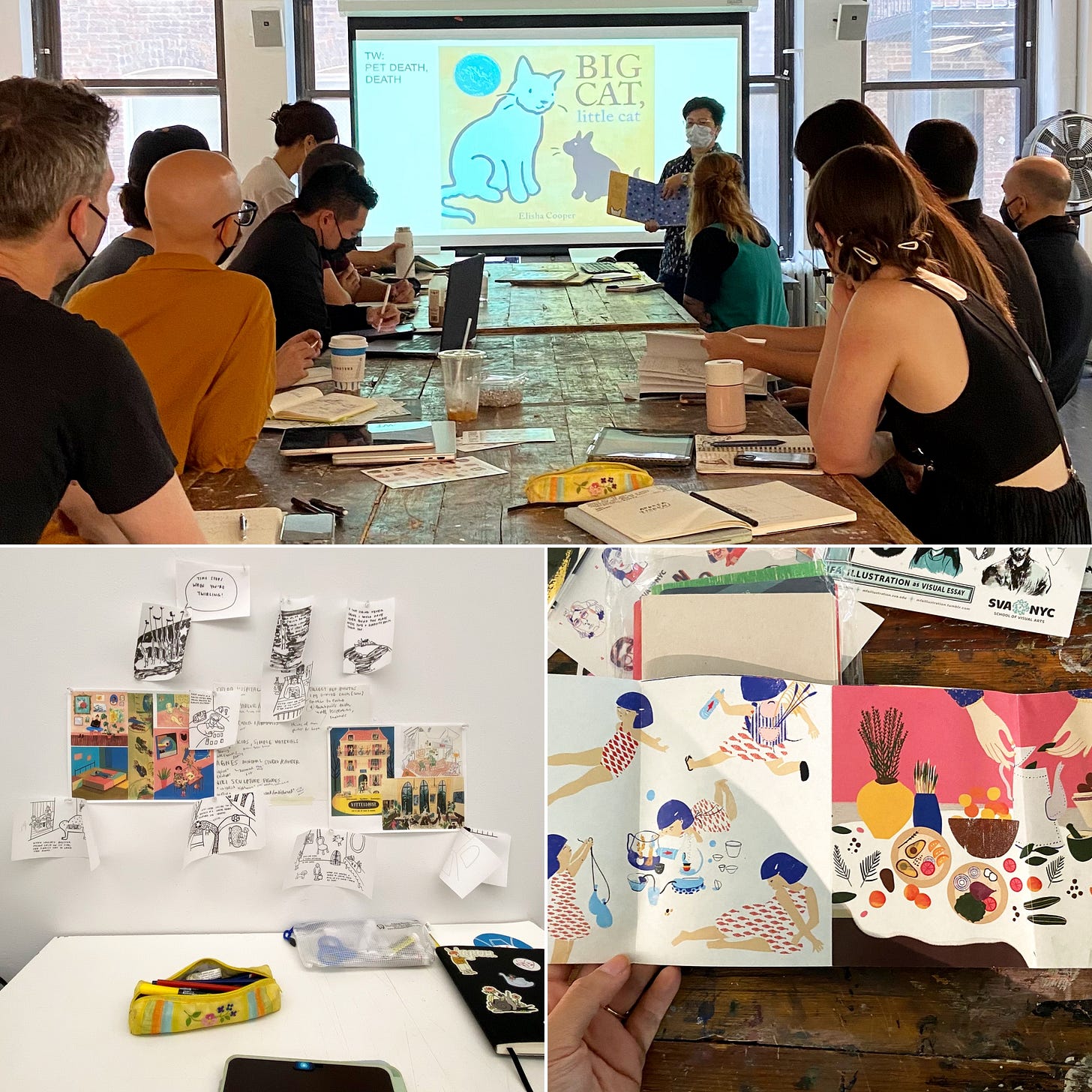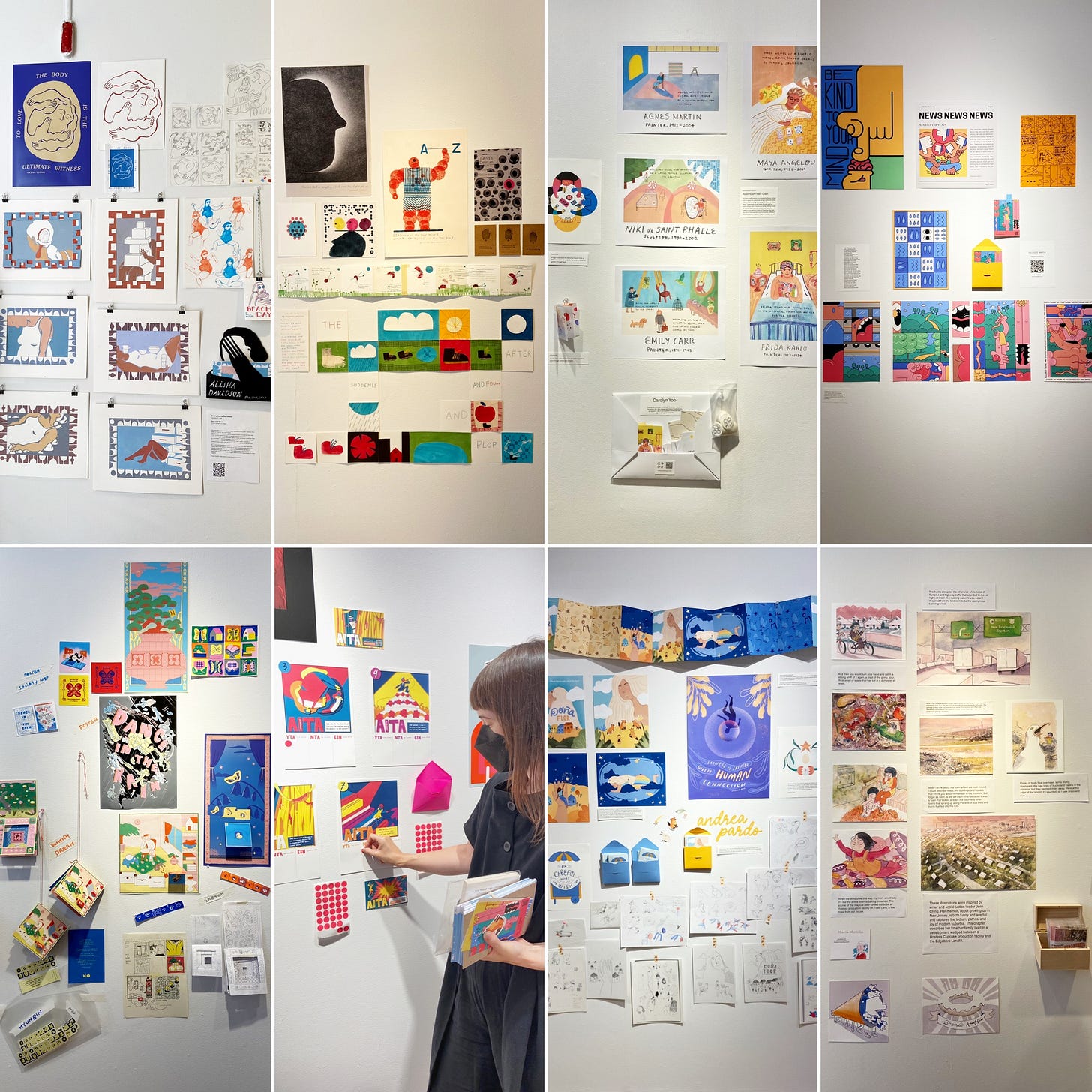Hi! Hope you all have been having a lovely summer (it’s not over yet ☀️) What was meant to be a month away while I attended my SVA residency turned into a two month hiatus. That’s given me a lot of time to reflect on the program and my experiences there, which I’ll be sharing with you today!
What is a residency?
Residencies are programs where artists and writers can work deeply on their art outside of their usual environment. Some programs are fully funded with housing (the dream!) Many don’t have specific instruction, but do provide resources and programming so that residents can share work with each other and to the general public.
The five week SVA illustration artist residency that I joined in July was slightly different, since it was part of a university’s continuing education programming. There were dedicated classes with teachers, so it felt more like a learning intensive / mini MFA program. The residency was also based in NYC where I live, so I didn’t need to leave home. However I did take time off from my day job and was leaving the house every day to commute to school, so it was a contrast to my normal WFH routine. The five weeks culminated in an open studios exhibition where we could show all the work we had made to the public.
How did you hear of and get into the residency?
I found out about the residency last year while taking other courses at SVA and made it a goal to apply in 2022, especially if it would be in person (which it was!) I was so curious what it would be like to immerse in my art practice with the support of teachers and other artists, especially since I’ve never been to art school. There are very few immersion programs dedicated to illustration outside of a BFA or MFA, so I jumped when I had the chance.
To apply to the program, I prepared my portfolio on my website and wrote an artist statement and CV (this generator was great to use). This was my first time making or writing any of these things, so the application gave me a good reason and deadline to try it out! My advice to you would be to start early and get lots of feedback from other artists.
Who else was in your program?
Our class was a group of 16 from all over the world, including Argentina, Colombia, China, Korea, and Saudi Arabia! There were a few others local to NY too. Many were designers who wanted to develop their illustration portfolios and others had already been working as freelance illustrators. We had a wide breadth of interests—some were interested in editorial, others in children’s books, and others in character design and animation.
What did you learn?
There were three components to the residency—the portfolio (led by Viktor Koen), narrative and sequential storytelling (led by Maëlle Doliveux), and the personal project (led by Anna Raff). Each week we had one of each class along with guest lectures and portfolio reviews.

In the portfolio class we were given four assignments (a logo, poster with quote, book cover, and editorial illustration), each of which we could continue to advance beyond the sketch stage. These classes comprised of hours of group critique reviewing each others’ works in progress at various stages. Below are some tips from Viktor that I jotted down from these critiques:
Think of your personal agenda. We want to draw and express the things we like (while getting paid!)
It’s not recommended to have two degrees of separation from symbol to symbol to represent a concept. For example, our editorial illustration was about startup copycats. One degree of separation is a cat, two degrees would be a mouse. Having a cat chase a mouse would make sense since the cat grounds the symbolic representation, but having only the mouse would be difficult to tie back to the “startup copycat” theme.
The sequential/narrative class was chock full of information and inspiration. Maëlle brought loads of books each session for us to peruse, which were so helpful to not only discover new artists but also to examine different printing methods and storytelling techniques. We were challenged to keep an idea bank of words and images to serve as future inspiration, and to try telling stories through a one page zine and accordion format. I was very inspired to tell a wordless story with primary colors, which proved to be much harder than I thought it would be!
I most looked forward to the personal project, and Anna was a wonderful guide throughout this process especially because she had an appreciation for my colorful and playful style suitable for children’s books. You can see more of my final project here, as well as some photos from our final exhibition below:

Here are some tips I jotted by way of Anna:
People have to be able to understand what you’re drawing. Keep it simple and recognizable.
A thumbnail makes sense to you. A sketch makes sense to others.
“You’re going to have a hard time once you learn how to draw better.” Marshall Arisman said this to Anna during her MFA and it left a deep impression on her. She told this to me multiple times and it has really resonated with me and given me confidence to see my loose, childlike drawings as a strength!
We also had several guests who either gave presentations about their own work or gave lectures about the industry such as book publishing. After the presentation, each of us had our portfolio reviewed for three minutes—a short time, but long enough to see what pieces the guests responded to!
Some memorable quotes from our guests:
“There are two types of illustrators - ones who are style-oriented, and ones who are problem solving oriented.” - Lauren Panepinto, VP at Hachette.
This Tom Froese video talks about this exact topic!
“The story emerges by making it.” - Andrea Tsurumi, children’s book author.
I was really fascinated to see different author/illustrators’ processes, especially how some find the story first by writing and others by drawing. I love that having writing and drawing in your toolbox means that you can see the story emerge by playing with both mediums!
How did you feel? How did you grow?
I am so glad I did the program, and I am so glad it is over. I had pretty big mental health struggles while finishing work for the exhibition, though it was ultimately rewarding to have people see my work on the wall and discover something new. I thought that I should be making art all the time because I had no other obligations; I quickly learned that taking breaks is crucial and trying to force progress leads to overthinking and spiraling.
I believe I would have benefited more from this residency if I had made a lot more work prior to it. My takeaway leaving the program is also to make a lot more work. After all of the worry and overthinking I did at the residency, I realized that trying to problem solve in my brain during the final illustration stage is counterintuitive and that sometimes I need to call a piece done and move on even if I’m not fully satisfied, as long as the idea and feeling comes through. The overthinking was seriously killing the joy in creating and if there’s no joy, what’s the point?
I was pleased to discover that my portfolio reviewers confirmed that I had a clear illustration style, something I was fretting about just a few months ago. I also clarified my process going from sketch to final illustration and learned a bunch of useful Photoshop tips. I’m happy to have clarity about the illustration markets I want to be a part of (women’s lifestyle, food, children’s books) and to see my work reflect that more and more.
To wrap up, I’ll end with some notes in my journal that comforted me during my bad mental health days. I hope they can be some comfort to you too 💛
Release needing to be talented or even good. Prioritize being reliable, personable, and humble.
Good is subjective. Reliable is not.
Confidence is crucial. So is self-compassion.
It is not my ideal vision, but it’s the best we can do for now. That is enough.
You’ll never feel ready. Send it now!





Such a fantastic recap of your residency - It feels like I was there soaking up those nuggets of wisdom.
I’m finding myself struggling with the same things in my practice - being a perfectionist, feeling ready, figuring out what kind of illustrator I am - and I appreciate your tips to overcoming those things so much 🧡
Love seeing how your illustrations are so unique. I can pick them out from a lineup of your peers and it’s starting to form it’s own visual language 💕